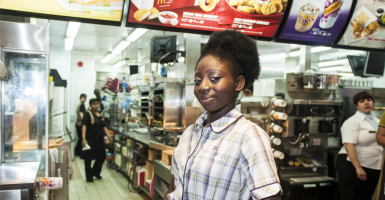The protests outside fast-food establishments last week featured calls for a $15 hourly wage. Unemployment is only the most obvious unintended consequence we could expect under such a large forced increase in wages. For consumers, the most noticeable difference would be the price of fast food: A typical fast-food meal would probably cost about $2 more. For example, a Big Mac meal would cost $7.82 instead of $5.69.
My Heritage Foundation colleague James Sherk used research on the price responsiveness of fast-food consumers to calculate how a typical fast-food establishment would respond to an increase in wages from $9.04 (the 2013 average) to $15.50. If the high wage were imposed, prices would rise on contact because the wage bill would vastly exceed most establishments’ small profit margins.
But the reactions wouldn’t stop there: Faced with higher prices, consumers would buy less fast food, substituting home cooking, prepared food and sit-down dining. The appeal of fast food, after all, lies in its cheap convenience. With lower sales, restaurants would most likely raise prices even more (and lay off staff) to maintain profitability.
Sherk estimates that in the short run, prices would rise 38 percent, production and hours worked would fall 36 percent, and wages would decrease to 1 percent of revenue from 3 percent in 2013. In the long run, some restaurants would close, and the survivors would shift to fewer, higher-skilled workers and more labor-saving technology.
Some workers would come out ahead from a $15 fast-food wage: those with the most experience and the highest efficiency. Sadly, marginal workers–including those with the worst alternatives and the fewest marketable skills–would be left behind.
Originally appeared on WSJ.com.





























